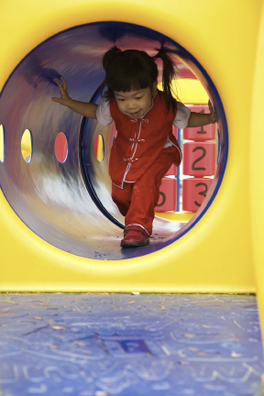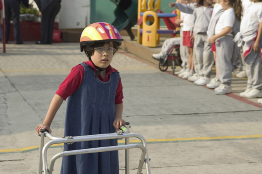Session 1
1. Session 1
1.1. Inquiry 1
Session 1: Physical Development
Inquiry 1: Physical Development
To gain an overview of the physical development of children between the ages of birth to six years, watch the video “Physical Development.”
By understanding how children grow and change, you are better able to respond to each child’s needs. This process of growth and change is called development. Children develop socially, physically, intellectually, creatively, and emotionally. Perhaps the easiest growth to recognize is physical development.
The physical development of young children takes them from infancy (when they have little mobility and little control over their movements) to childhood (when their movements are highly refined, allowing them to participate in a wide variety of activities and choices). Physical development consists of a coming together of gross motor development, fine motor development, and sensory perceptual development.
gross motor development: the development of gross motor skills, which are used in the control of large muscles of the back, arms, legs, and shoulders
Gross motor skills are required for activities like walking and jumping.
fine motor development: the development of fine motor skills, which are used in the control of small muscles in the hands and fingers
Fine motor skills often require hand-eye coordination; for example, learning to control a crayon requires fine motor skills and hand-eye coordination.
sensory perceptual development: the development and use of sight, hearing, taste, smell, and touch
Course Project
This is your first reminder to start thinking about your Course Project: Strategies Box. As you progress through this session, you should be working on items and strategies to include in your strategies box. How can you apply the information from the video about physical development to items and strategies for your box?
Gross Motor Development

© Quavondo/iStockphoto
Gross motor (large muscle) development involves the control of large muscles of the legs, arms, back, and shoulders needed for movements such as running, jumping, climbing, and crawling.
Walking from place to place, running, jumping, hopping, and throwing are key play skills. Balancing is also an important skill for children to learn. All of these skills become more advanced as children develop coordination during the preschool years.
Consider the following examples of gross motor activities:
- chasing bubbles
- walking on a rainbow path taped to the floor
- crawling through a maze made out of cardboard boxes
- dancing to music
- putting a blanket on a chair to make a tent
- stepping through tires
- doing somersaults
- rolling like a log down an incline
- playing with a parachute
- stepping in and out of hoops lying on the ground
- climbing steps on the slide
- throwing bean bags
- throwing balls
- pulling and pushing wagons
- riding toys and bikes
- riding a bouncing toy
- filling and emptying sand buckets
- following the leader
- rolling a ball to a partner
- hopping on one foot
- playing catch
- climbing playground equipment
Fine Motor Development
manipulatives: objects that are moved by children’s hand and finger muscles
Fine motor (small muscle) development is involved in the use of small muscles of the fingers and hands. These muscles are needed for holding eating utensils (e.g., spoons), writing, drawing, and doing up buttons. During the infant and toddler years, children develop basic grasping and manipulation skills. The preschooler uses these skills to hold utensils, put on socks, and draw pictures. Playing with manipulatives improves fine motor skills.
Consider the following examples of fine motor activities:
- putting together puzzles
- drawing
- painting
- gluing
- placing pegs in a peg board
- manipulating objects to fit inside other objects
- playing with blocks
- rolling trucks and cars
- dressing dolls
- latching clothing
- pouring sand or water
- sifting sand or water
- manipulating eating utensils
- turning pages
- combing hair
- brushing teeth
Sensory Perceptual Development
Children learn information through their senses. As they move their small and large muscles and use their sight, hearing, taste, smell, and touch, they are learning about the world.
hand-eye coordination: the use of vision to control and adjust hand movements
kinesthetic awareness: the sense of awareness and feeling for one’s body in space
physical growth: changes in body characteristics such as height, weight, muscle, and bone development
Hand-eye coordination is also part of physical development. The term kinesthetic awareness describes the sense of awareness and feeling for the child’s body in space. This skill helps children make judgments about movement.
Physical growth refers to changes in body characteristics such as height, weight, muscle, and bone development. Patterns of physical growth and motor development are predictable, but each child is unique and develops at her or his own rate. Development is the outcome of growth, maturation, and learning.
Maturation refers to the gradual changes in the child’s body due to normal growth processes. As children mature, they become more able to learn certain skills. Again, individual children develop at their own individual rates.
Course Project
Now that you have looked at the difference between fine and gross motor skills, take time to apply this information to making items and strategies for your strategies box.
Developmental Milestones from Birth to Five Years
The table “Developmental Milestones from Birth to Five Years” provides information on typical development by age. As always, remember that individual children develop at their own individual rates.
Checking My Understanding
Physical Abilities of Young Children
Directions
In this “Physical Abilities of Young Children” drag-and-drop activity, you will determine whether each activity would promote gross or fine motor development and for which age group the activity would be most suitable.
Course Project
How do the items and strategies in your strategies box promote children’s development of gross and fine motor skills at different ages? Remember, it is recommended that you work on making your strategies box as you progress through this and the other sessions in CCS3120.
Factors Affecting Physical Growth and Motor Development
Gender
There are few differences in the physical growth of boys and girls. While girls do typically mature earlier than boys, in early childhood the differences between them are most often related to differing expectations for boys and girls. For example, even as toddlers, boys are more often encouraged to participate in active games, whereas girls are encouraged in quiet play, such as doing puzzles.
Can you observe these differences during your interactions or as you watch others interacting with young children?
Culture
Children all over the world are brought up in different ways. Some skills may be mastered earlier than others because those skills are necessary in a family’s culture. For example, a very young child may be encouraged to learn the coordinated fine motor skills necessary to sew, weave, or use chopsticks depending on his or her family’s culture.
Environment or Life Experiences
The environment in which a child lives and learns can influence the child’s growth and motor development. Consider the following factors.
- Opportunity. The opportunity a child has to gain or practise a particular skill can determine whether or not and at what age the skill is learned. Opportunities to learn include not only the equipment and materials the child has to play with, but also whether the child is encouraged to try an activity.
- Stimulation and Affection. Stimulation and affection are necessary for children to grow and develop, particularly in the early years. Research has shown that infants who receive little caring and/or stimulation develop much more slowly than those who receive a lot of caring and/or stimulation.
- Climate. Climate creates different opportunities for children’s physical development. For example, a child who grows up in a cold climate learns how to move in heavy clothing in the snow or on ice.
- Safety. Safety is another important aspect of the environment. Children must have a safe physical environment as they grow and develop skills. The following safety considerations are particularly important.
– Be aware of the safety of playground equipment as well as the child’s safety while using the equipment. Be sure that children are using the equipment appropriately. Also ensure that the playground surface is free from objects that could cause harm (e.g., glass, sharp twigs, needles).
– Consider age level of the children and food allergies and restrictions when planning snacks, meals, and cooking activities (e.g., peanut allergies).
– Staff should update their first-aid and CPR training annually.
– Select appropriate equipment and materials for the age level. Some materials that children enjoy should be used only with adequate supervision (e.g., climbing equipment).
– Follow safety guidelines when choosing and maintaining play equipment to prevent safety hazards.
Nutrition
Good nutrition provides the foundation for growth and, therefore, development. Poor nutrition in infants can lead to slow or impaired growth. Continuous poor nutrition does not provide adequate energy for active learning. Did you know that children learn to eat a variety of foods if they are offered a variety of healthy foods? Did you know that lifelong beliefs, attitudes, and habits about food and health are established in early childhood?
For more information about the nutritional needs of young children and/or ideas for how to promote healthy eating habits among children, check out information provided by Health Canada. You might try an Internet search using the term “Eating Well with Canada’s Food Guide.”
Health

© andres balcazar/iStockphoto
Children who are often ill lose opportunities for active play that promotes healthy physical development. Paying close attention to controlling the spread of germs will help ensure that children are healthy and have the desire and energy to play. More information on controlling the spread of germs will be provided in CCS3150.
Heredity
Heredity refers to the biological traits you get from your birth parents. Height, weight, aspects of body structure, and the rate of body growth can be hereditary. For example, a child’s height may be like the height of one or both of his or her biological parents.
Diverse Abilities
Children’s physical development may be limited by their diverse abilities or by exceptions to their abilities. For example, a child with serious asthma may not be able to run to the same extent as other children. Some children may require special assistance and/or adaptations to equipment based on their abilities or special circumstances.
All children, regardless of their abilities and any special circumstances to their abilities,
- have self-concepts that need to be enhanced through movement experiences
- need attention and have feelings
- need to feel wanted and loved
- process information
- have desires to improve their motor proficiency
- vary in their individual movement ability
- need encouragement and to be challenged
- need their successes celebrated
- want and benefit from being involved in decision-making processes
Attitude
Active play is important for children. The value of physical activity as a lifelong habit should be reinforced from the time a child is very young. Physical activity is not something done “in between” learning activities at the centre. Rather, physical activity must be viewed as one of the most important learning activities of the day.
Course Completion Checklist
Have you remembered to update your Course Completion Checklist? If you haven’t already started to use the checklist, access it in the Toolkit now. Remember to update the Course Completion Checklist every time you work on the course.
Course Project
Don’t forget to apply what you have learned to working on your Course Project: Strategies Box. Remember that you won’t always be reminded to work on your strategies box. It is a good idea to spend some time on your strategies box at the end of each inquiry, if not more often.